Nepal Travel Guide
This small, landlocked country located between Tibet and India contains eight of the world’s ten highest peaks, including Mount Everest. It is also home to the city of Lumbini, the birthplace of Gautama Buddha, the founder of Buddhism, and boasts a rich cultural heritage.
I spent nearly two months backpacking in Nepal, completing several treks and visiting major tourist attractions. Whether you are planning a mountain-focused trip or a cultural journey, this guide provides all the tips and information you need to organize your trip in the best possible way, always with a focus on budget.
Quick menu
- When to visit Nepal
- Documents and vaccinations to enter Nepal
- What to do and see in Nepal
- Suggested itineraries in Nepal
- How to get around Nepal
- Backpacking Nepal: costs
- Backpacking Nepal: safety
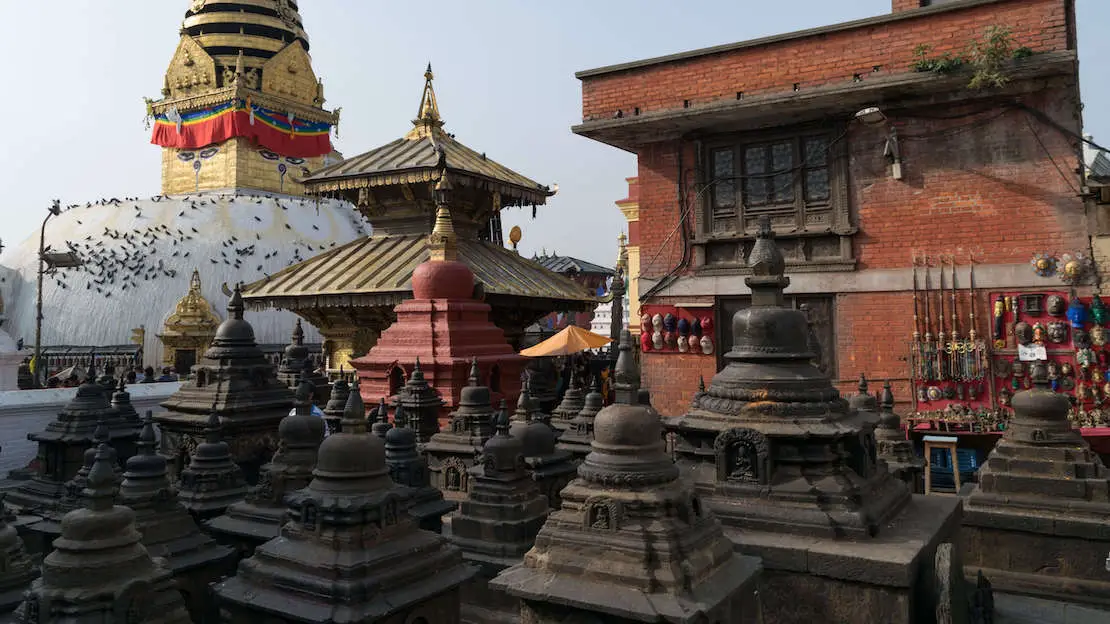
Monkey Temple, Kathmandu.
When to go to Nepal
Much of Nepal enjoys a temperate climate year-round, with four distinct seasons. Autumn (September, October, and November) is considered the best time to visit, especially for trekking. After the summer monsoons clear away pollution and dust, mountain visibility is optimal. Temperatures are also ideal, with low altitudes being pleasantly warm and high altitudes not too cold. Additionally, two of the country’s most important festivals, Dashain and Tihar, occur during this season.
However, fall is the most expensive and crowded time of year, especially in October, with accommodations along major trekking routes at high altitudes frequently selling out.
Nepal can be visited year-round, as long as your activities and destinations match the season. Here’s a look at the other seasons:
Winter (December, January, and February): The weather tends to be sunny and stable. This is an excellent time to visit the Terai, the southern region of the country at the foot of the Himalayas, including Kathmandu. The relatively low altitude means there is no snowfall, and although mornings can be cool, the rest of the day offers pleasant temperatures. Low-altitude trekking is possible. With the right equipment and barring heavy snowfall, it is technically possible to trek to high altitudes and complete popular routes like the Everest Base Camp trek and the Annapurna Circuit, but it is not the ideal time to do so.
Spring (March, April, and May): This is the second most popular season to visit. Temperatures and visibility for trekking are good, but moisture often accumulates in the afternoons, covering the peaks with clouds. The advantage of less crowded trails and the blossoming of numerous plants and flowers (especially rhododendrons) makes spring a great time to visit, particularly for those who want to trek and avoid the high season of autumn.
Summer (June, July, and August): This is the monsoon period, which typically starts in the first weeks of June and can extend into September. It’s an interesting time to visit as nature comes to life, the air is clean, and butterflies are everywhere. However, trekking is largely discouraged except in areas known as “rain shadows,” where rainfall is significantly lower. This includes the northern part of the Annapurna Circuit (Manang, Upper Pisang, Muktinath), though there is still some rain, especially at low altitudes. Risks such as blocked roads due to landslides and the presence of leeches should be considered.
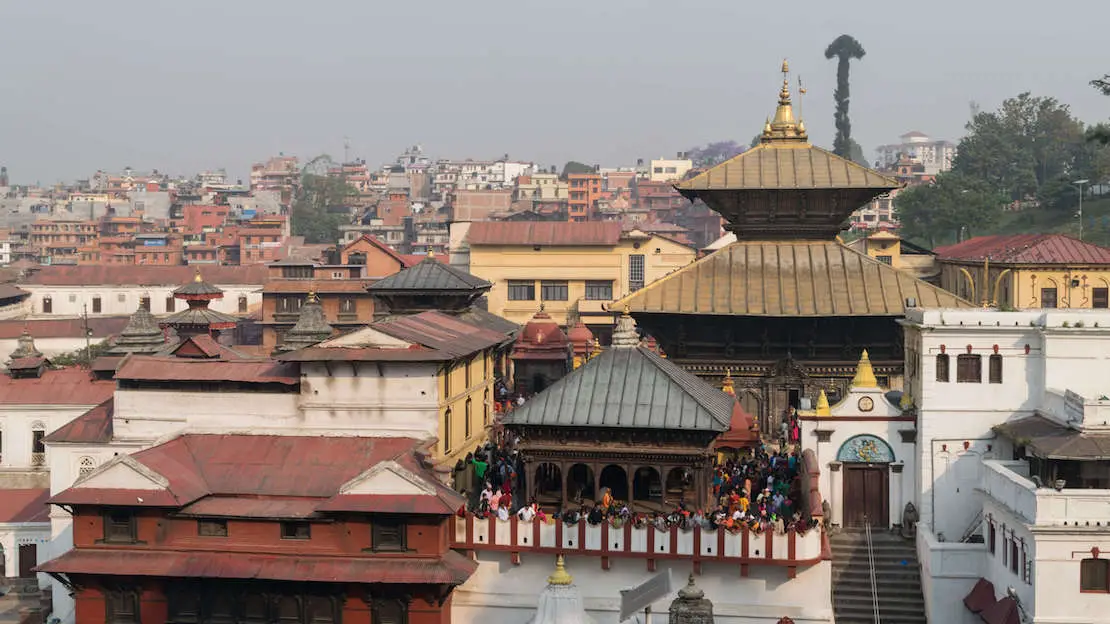
Pashupatinath Temple, Kathmandu.
Documents and vaccinations to enter Nepal
Let’s start with the visa to enter the country. A visa is mandatory but fortunately most passport holders (with an expiration date of less than 6 months) receive a visa called Visa On Arrival (VOA) the moment they enter the country. The process is extremely simple and straightforward but unfortunately it is not free.
There are three options:
15 days – 25 USD.
30 days – 40 USD.
90 days – 100 USD.
The visa can easily be extended to a maximum of 150 days per calendar year (January 1-December 31), although it is not exactly cheap. You can find the costs here; it is probably best to leave and re-enter the country with a new visa. In any case, with a tourist visa, you cannot stay in the country for more than 150 days per calendar year.
Two passport photos (passport-size) are also officially required to complete the visa process once you arrive at the airport/land border. However, if you complete the form online (it stays in the system for 15 days so don’t do it too far in advance) they are not required and you will most likely save quite a bit of time upon arrival, especially at the Kathmandu airport where you can head straight to immigration without standing there filling out the form.
The visa at Tribhuvan airport can theoretically be paid by credit card, but in practice, from what I have read, it varies day by day. I tried it and was told it was impossible. All major currencies (including euros) are accepted. To avoid unfavorable exchange rates, ideally, you should pay in U.S. dollars, but I wouldn’t dwell on it too much unless you already have them.
As for land borders (find the full list here) apparently only U.S. dollars are accepted, so adjust accordingly.
Nepal does not require any mandatory vaccinations but Hepatitis A and B are recommended.
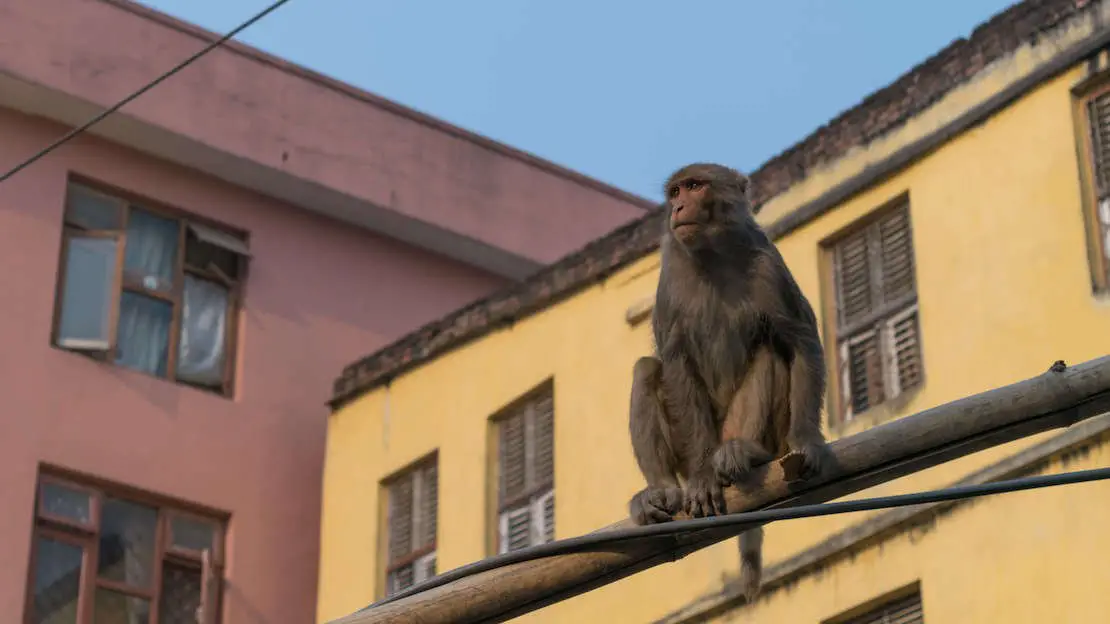
Kathmandu.
What to do and see in Nepal
In this guide, prices are expressed in the local currency called “Nepalese Rupee” often abbreviated simply as “NRP.” The exchange rate at the time of publication of this article is 1€ = 145 NRP. For the current exchange rate, I suggest you look at this page.
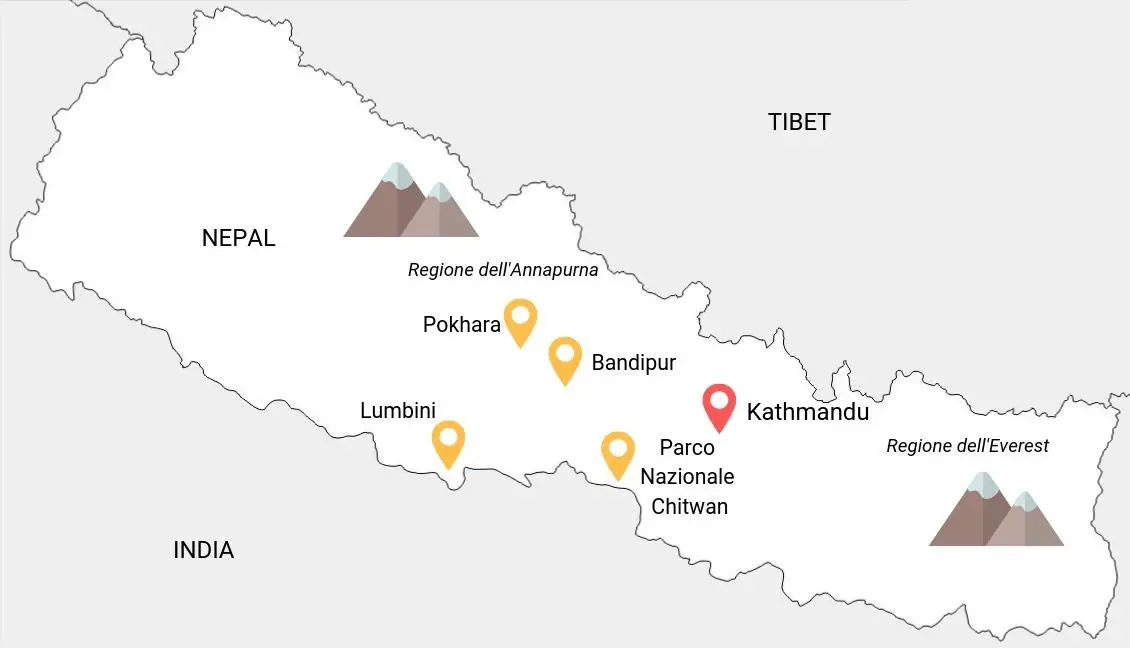
Kathmandu
Kathmandu is the largest city and the country’s capital; the only international airport is also located here, making it the starting point for most people visiting Nepal.
What to do and see in Kathmandu
The city and its surroundings can easily keep you busy for days with its squares, temples, and historic districts, offering a wealth of choices. Walking the streets of Thamel, the city’s tourist district, is particularly enjoyable if you are looking for souvenirs to take home. Here are the main tourist sites in and around Kathmandu.
Kathmandu Durbar Square
This is undoubtedly the most iconic square in Kathmandu (Google Maps) and, more generally, in Nepal. It is a UNESCO World Heritage site that contains numerous temples and palaces. Unfortunately, like many historical sites in the city, the buildings suffered serious damage during the 2015 earthquake and are still being rebuilt. However, it is definitely worth a visit.
The square can easily be reached on foot from Thamel, and I highly recommend this route as the streets you pass through are vibrant with life. Visit early in the morning when the square comes alive with locals crowding the various temples and bringing their offerings.
Entrance for foreigners is quite expensive, costing 1,000 NRP. However, it is possible to enter for free by blending in with the crowd or through some back alleys.
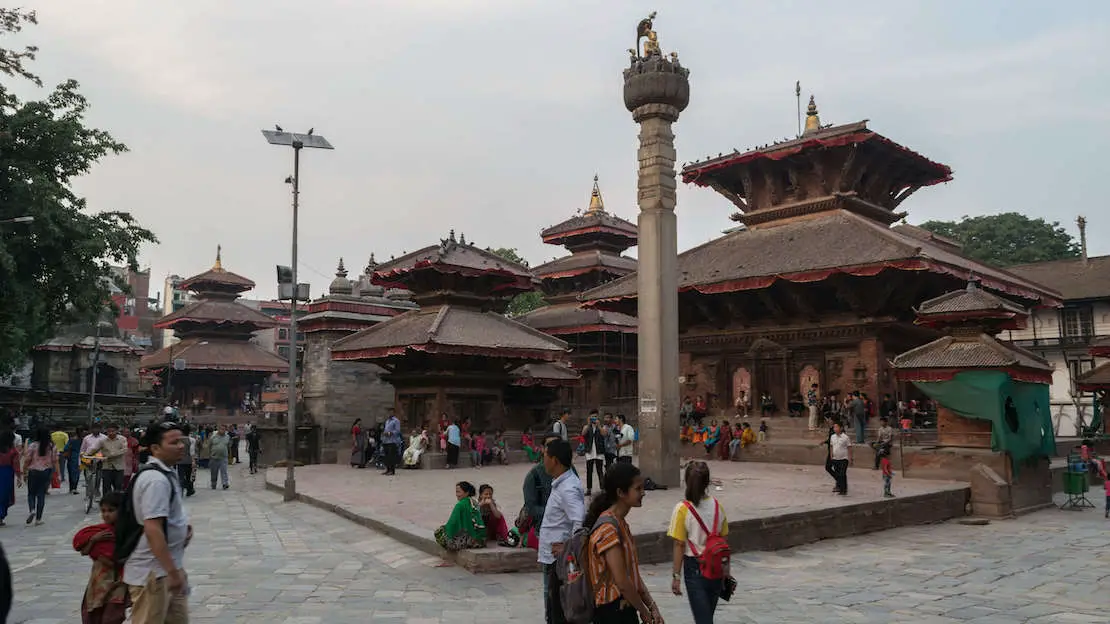
Kathmandu Durbar Square.
Swayambhunath Stupa (Monkey Temple)
This temple, located atop a hill overlooking Kathmandu (Google Maps), offers excellent views of the city and the entire valley. The main stupa with the Buddha’s eyes and golden spiral stretching skyward is truly fascinating as are all the small temples surrounding it.
The entire area is literally infested with monkeys (not surprisingly, the temple has been nicknamed “Monkey Temple”) which makes it even more interesting especially for those who have never dealt with these cute creatures.
Don’t forget to also visit the lower part of the complex facing west. I was told that admission cost 200 NRP but probably having entered through a back staircase I unintentionally avoided paying.
To get to the site you could easily walk from Thamel. It is in fact only 3 kilometers in the middle of decidedly un-touristy neighborhoods. Or take one of the many minibusses that run along this road north of Thamel, the destination you will hear shouting or have to ask is “Swayambhu,” the cost is only 15 NRP.
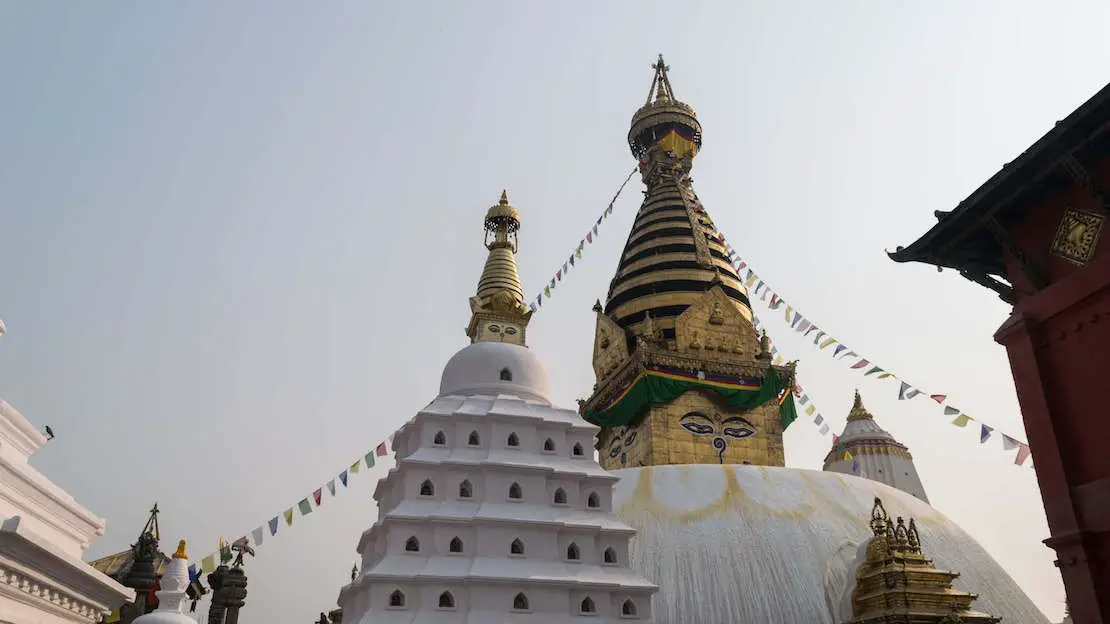
Swayambhunath Stupa (Monkey Temple).
Pashupatinath Temple
More than a temple, it is a complex of Hindu temples (Google Maps). The main one, dedicated to Shiva, is the largest in the country and one of the holiest. Access to this temple is restricted to Hindus only, but the rest of the complex is accessible to anyone.
Admission again is quite expensive, 1000 NPR, but once you get to the main entrance just take a right and cross the river to explore the complex for free.
To reach the site from Thamel I simply walked. It is in fact only 4km, but if you prefer to use public transportation you can board the blue line at this point near Ratna Park, 20 rupees. Of course, a taxi is always an option.
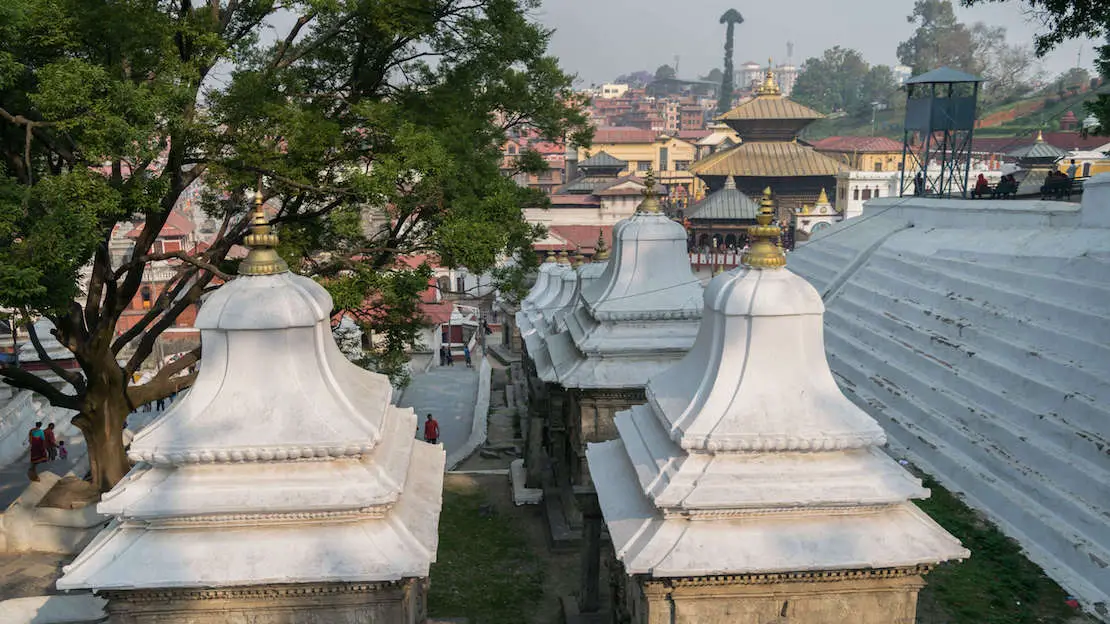
Pashupatinath temple complex.
Boudhanath Stupa
It is one of the largest in the world and is indeed a very impressive site. The stupa is located within a truly stunning circular plaza and is without a doubt one of my favorite sites in Kathmandu (Google Maps).
I recommend combining the visit with the nearby Pashupatinath Temple, which is less than a 2km walk away. Again, if you wish, you can avoid paying the NPR 400 entrance fee by entering through one of the many secondary entrances to the square.
To return toward Thamel simply board one of the blue buses that run along the road opposite the main entrance to the stupa and drop you off near Ratna Park for 25 rupees.
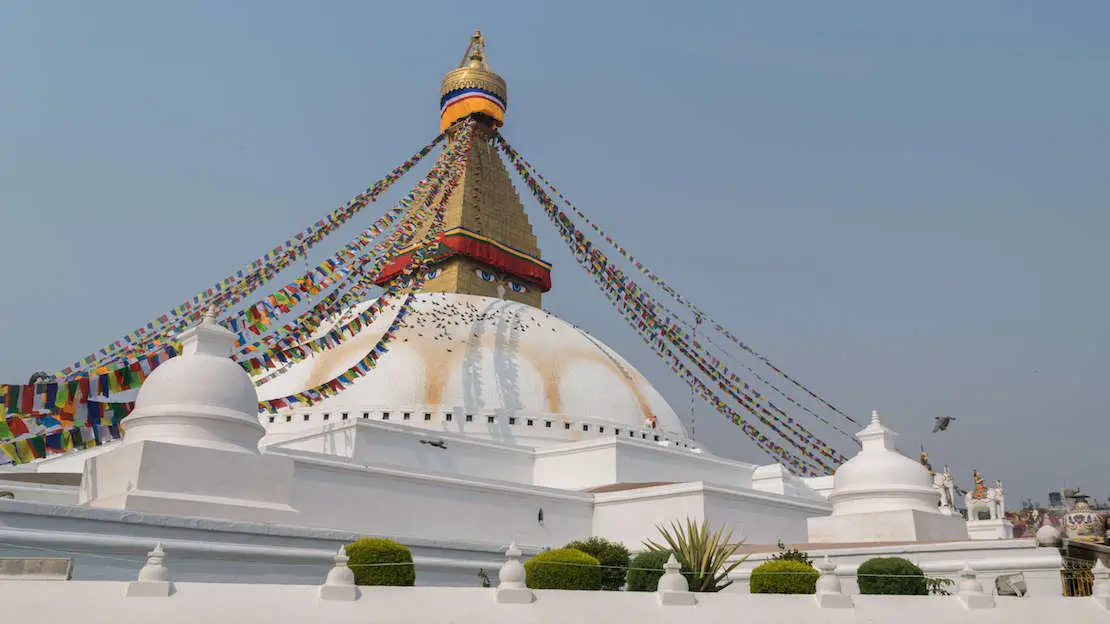
Boudhanath Stupa.
Patan Durbar Square
Patan is technically the oldest city in the entire Kathmandu Valley, to this day, being only 5km from the center of the capital, it is for all intents and purposes part of the Kathmandu metropolitan area, and distinguishing it from the rest of the city is almost impossible.
Patan retains a fine architecture made up of numerous historic buildings culminating in one of the most beautiful squares in the entire region, Patan Durbar Square (Google Maps). The square is extremely livable especially in the late afternoon when locals use it as a gathering place.
Again, entry is quite expensive at 1000 NPR but if you wish you can enter through one of the secondary entrances and avoid paying.
To get to Patan from Thamel, I recommend taking a minibus to “Lagankhel” at this point, the cost is 15-20 rupees, I recommend getting off at this stop and walking to the square which is only 1km from here.
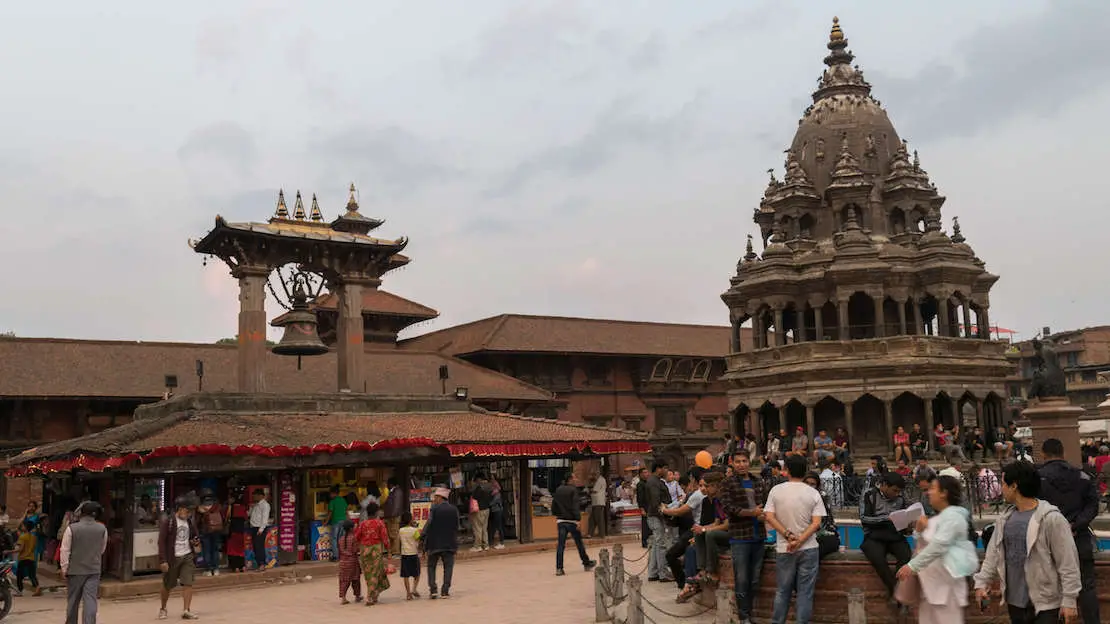
Patan Durbar Square.
Kirtipur
Kirtipur is definitely a far less popular destination than those mentioned so far such that during my afternoon spent walking the streets of Kirtipur I did not meet any other tourists.
The city is only 5 km from downtown Kathmandu, the old part is perched atop a hill where traffic is virtually absent and limited to a few scooters, all sites of interest are free admission. It is a great way to get to know ancient Nepal, away from mass tourism but within walking distance of the capital.
Half a day is more than enough time to explore the city.The main sites of interest are the Tri Ratna temple, Dev Pukko (center of the city with the queen’s palace attached), the Bagh Bhairab temple, and finally the Uma Maheshwor temple. Walking and getting lost in the streets of the ancient city is in itself really interesting and a great way to spend a couple of hours.
Finally, before returning to Kathmandu I strongly recommend eating at the Newa Lehana restaurant. Excellent traditional food is served here. Reaching Kirtipur is really easy, buses frequently leave from Ratna Bus Park and take about 25 minutes to reach Naya Bazaar at the base of the ancient city, 20 rupees.
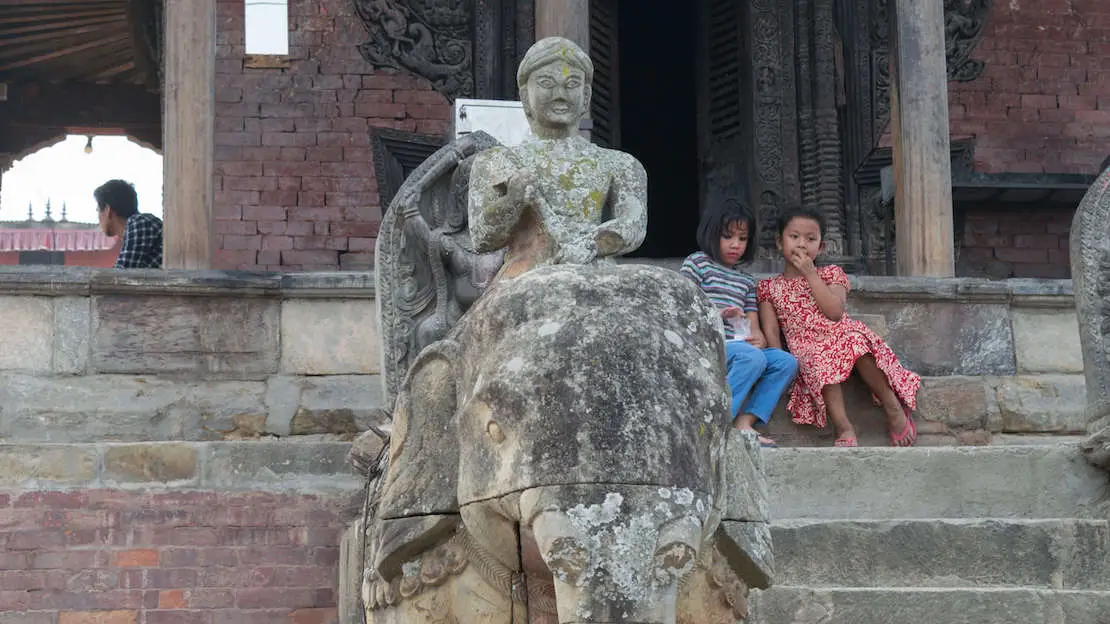
Uma Maheshwor Temple.
Bhaktapur
Bhaktapur city is about 12 km from Kathmandu. Bhaktapur is known by many names: culture city, living heritage, open-air museum, etc. etc. Bhaktapur was in fact the capital of the Kathmandu Valley until the 15th century and preserves many historic buildings and monuments. Unfortunately, many of these structures were severely damaged during the 2015 earthquake but the city still retains its charm.
The most important site is definitely the famous Bhaktapur Durbar Square (Google Maps) where the palace that housed the royal family until 1769 is located and is now the home of the National Art Gallery. Other notable sites in Bhaktapur are Taumadhi Square and Dattatreya Temple. Reaching Bhaktapur from Kathmandu is really easy, in fact there are buses that frequently leave from Bhaktapur Bus Park, 30 rupees.
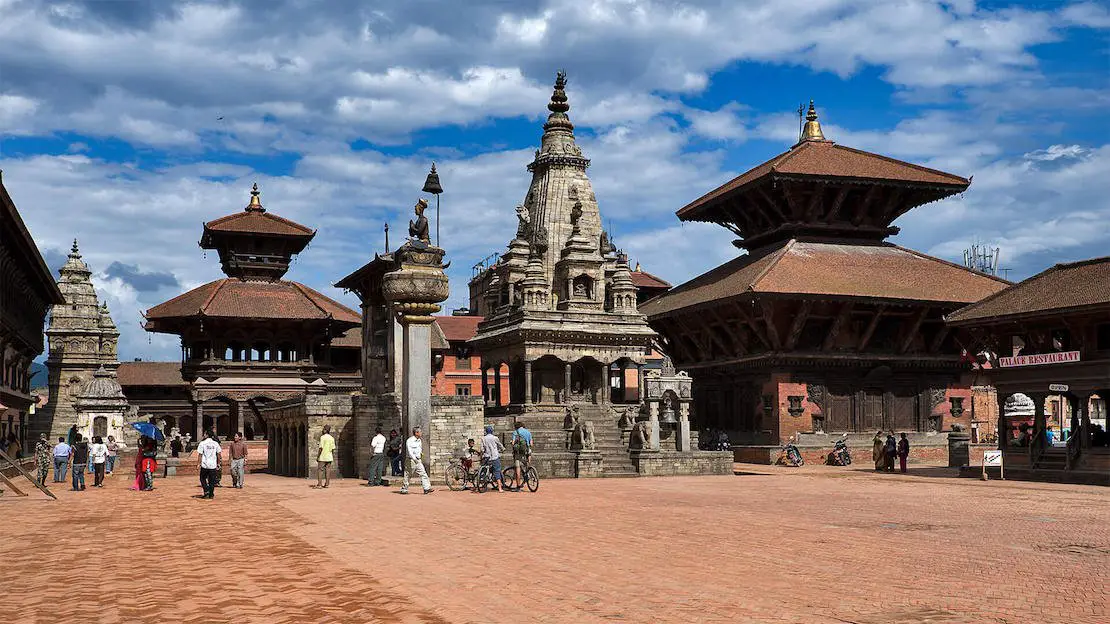
Bhaktapur Durbar Square.
Namo Buddha
Namo Buddha is a small village that houses the Thrangu Tashi Yangtse Monastery (Google Maps), which is one of the most important pilgrimage sites for Buddhists in all of Nepal and one of the holiest in the world. Legend has it that this is the place where Buddha, in a previous life as a prince, fed his body to a tiger and her cubs.
Reaching the village from Kathmandu is relatively easy. You can take a local bus from Ratna Park Bus to Banepa (2-3 hours) and here change for one bound for Namo Buddha.
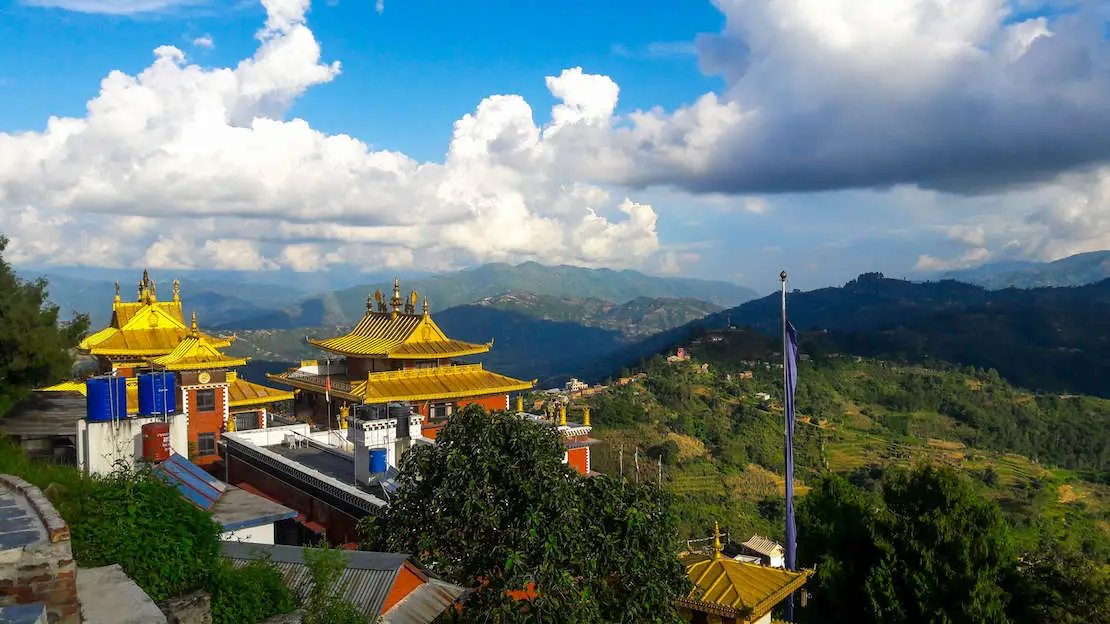
Thrangu Tashi Yangtse Monastery.
Where to sleep in Kathmandu?
I spent two weeks in Kathmandu, trying out several accommodations, first with Dad and then on my own while waiting for my visa to India. Here are my recommendations.
I spent two weeks in Kathmandu, trying out several accommodations, first with Dad and then on my own while waiting for my visa to India. Here are my recommendations.
Gurung’s Home – Good prices for both dorm and private rooms.
The Sparkling Turtle Backpackers Hostel – Great hostel at a very good price with really nice staff. The only downside is the location, it is in fact about 3km from the center of Thamel near the Monkey Temple, otherwise, it is highly recommended.
Andes House – Clean and inexpensive private rooms right in the center of Thamel.
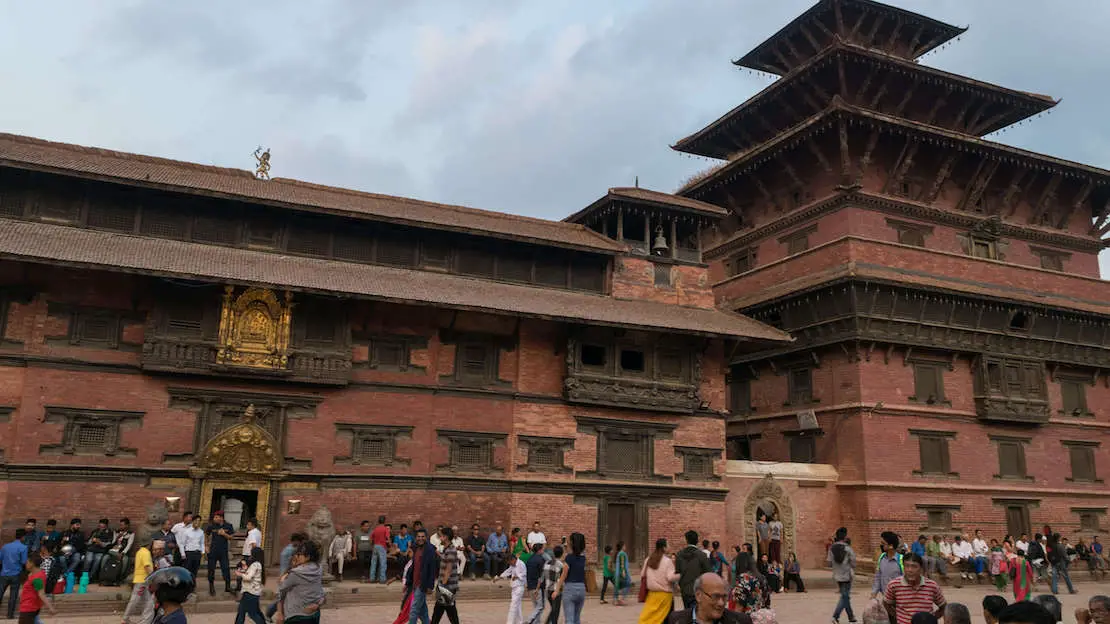
Patan Durbar Square.
Pokhara
Pokhara is the second largest city after Kathmandu and the ideal starting point for most treks in the Annapurna region.
Overlooking Lake Phewa, it definitely has a much more relaxed and less chaotic atmosphere than the capital city. For those looking for sites of historical/cultural interest it probably leaves a little to be desired but if nature is what you are looking for then you will definitely not be disappointed.
What to do and see in Pokhara
Most people visit the city briefly before or after one of the many treks the region offers. If you have a few days to spare, here are some sites you might visit in and around Pokhara.
Lake Phewa
Lake Phewa that the city overlooks is a great place to spend a few hours simply walking along its shores or perhaps renting a rowboat with or without a paddler. There is also a small island in the middle of the lake that houses one of the city’s most famous Hindu temples (Google Maps).

Lake Phewa.
The World Peace Pagoda
Also known as Pokhara Shanti Stupa (Google Maps), this is a Buddhist pagoda overlooking the city and the lake from the top of Anadu Hill. There are several ways to reach it, being just over 5 km from Lakeside (where virtually all the hotels are located) you can easily walk. The route is well mapped on maps.me/organic maps.
Alternatives are a short boat crossing of the lake (700 rupees one way, 1,000 round trip) and then walking for about 45 minutes or taking a taxi to the pagoda and walking the last stretch.
Sarangkot Viewpoint
This is probably the most spectacular vantage point in the entire city. Sunrise is undoubtedly the ideal time to visit this place and see the sun rise over the Annapurna massif.
Try to arrive at least 20 minutes before sunrise, from Pokhara it is about 40 minutes by taxi along a road not exactly in great condition, about 2000 rupees (Google Maps).
International Mountain Museum
Interesting museum about Nepal’s mountains, local communities, climbers, flora and fauna of the region (Google Maps). Also highlighted are historical expeditions and the impact of global warming on the mountains. In short, it is a place any mountain enthusiast is sure to find interesting. Admission costs 500 rupees, the museum can be reached on foot in about 45 minutes from the lakeside, a taxi costs about 300 NPR.
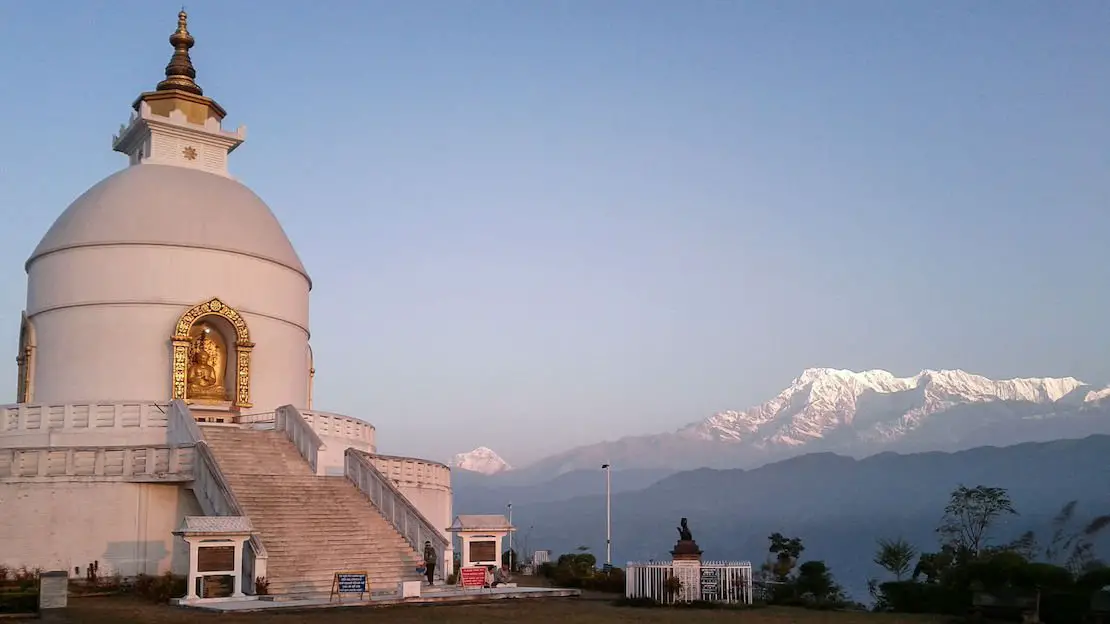
World Peace Pagoda.
Mahendra Gupha and Chameri Gufa
They are two not exactly spectacular caves that are about a 10-minute walk from each other, the first houses a small temple inside (Google Maps) and there are some interesting rock formations while the second is basically full of bats (Google Maps).
Devis Falls
Small waterfall just a stone’s throw from town but certainly won’t keep you busy for hours; entry costs 100 rupees (Google Maps).
Other activities that can be arranged in Pokhara are paragliding flights, the cost in tandem is about $50, rafting, bungee jumping, ziplining and yoga retreats.
Where to sleep in Pokhara?
HOTEL FORESTWAY Hostel & Backpackers – Good budget hostel 50 meters from the lake that also offers private rooms.
Hotel Santana – If you are exclusively looking for an affordable private room to sleep in before or after your trek, look no further.
How to reach Pokhara?
From Kathmandu to Pokhara, tour buses leave every morning at 7:00 a.m. from this point north of Thamel and reach the Tourist Bus Park in Pokhara in about 6-7 hours, costing from 600/700 NPR for standard buses, to nearly 3000 NPR for luxury buses. Local microbuses cost 400/600 NPR but the journey can be really uncomfortable. If you want, it is also possible to take an overnight bus but given the nature of the road it is probably not the best. There are also numerous daily flights, about 40 minutes, about 100$ one way.
If you are coming from India, there are daily buses from the border town of Sunauli to Pokhara for 600 NPR, about 8 hours.
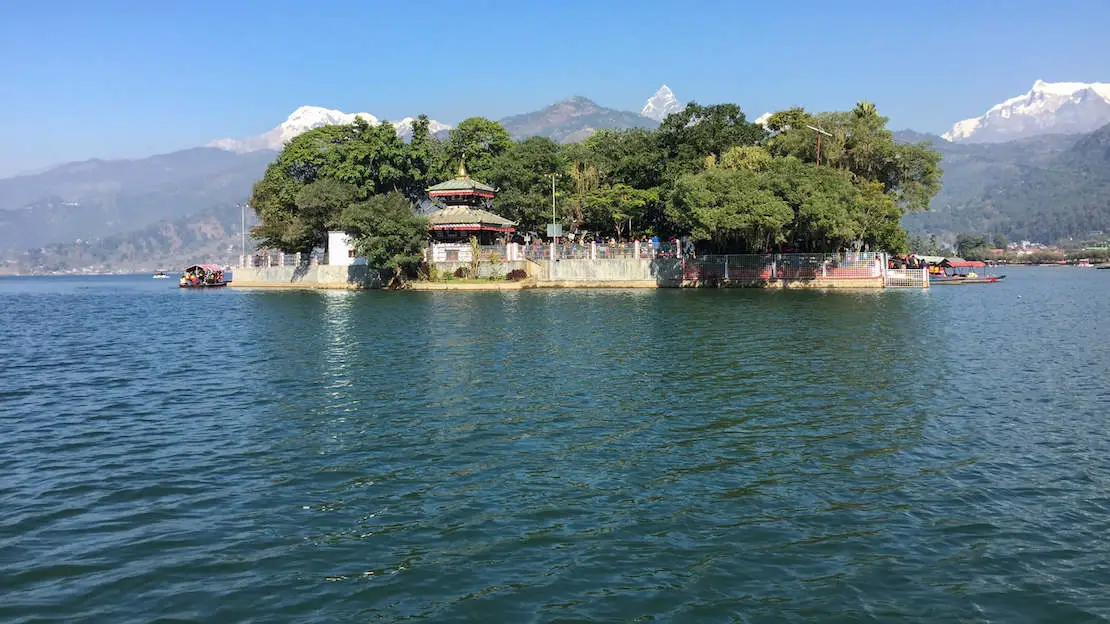
Talbarahi Temple.
Lumbini
Lumbini is the birthplace of the Buddha and a pilgrimage destination for anyone interested in the world of Buddhism.
There are many temples, built by numerous countries, and they are all concentrated within a confined area that can easily be visited within a day, perhaps on a rented bicycle (Google Maps).
Where to sleep in Lumbini?
Lumbini Garden Lodge modest private rooms at honest prices. If you are looking for something luxurious check out Hotel Buddha Maya Garden.
How to reach Lumbini?
There are daily buses from Pokhara and Kathmandu, but it is also possible to reach Lumbini from Varanasi as the town is only a few kilometers from the Sunauli border with India. Once across the border, reach Bhairahawa in a shared jeep and then board a bus bound for Lumbini.
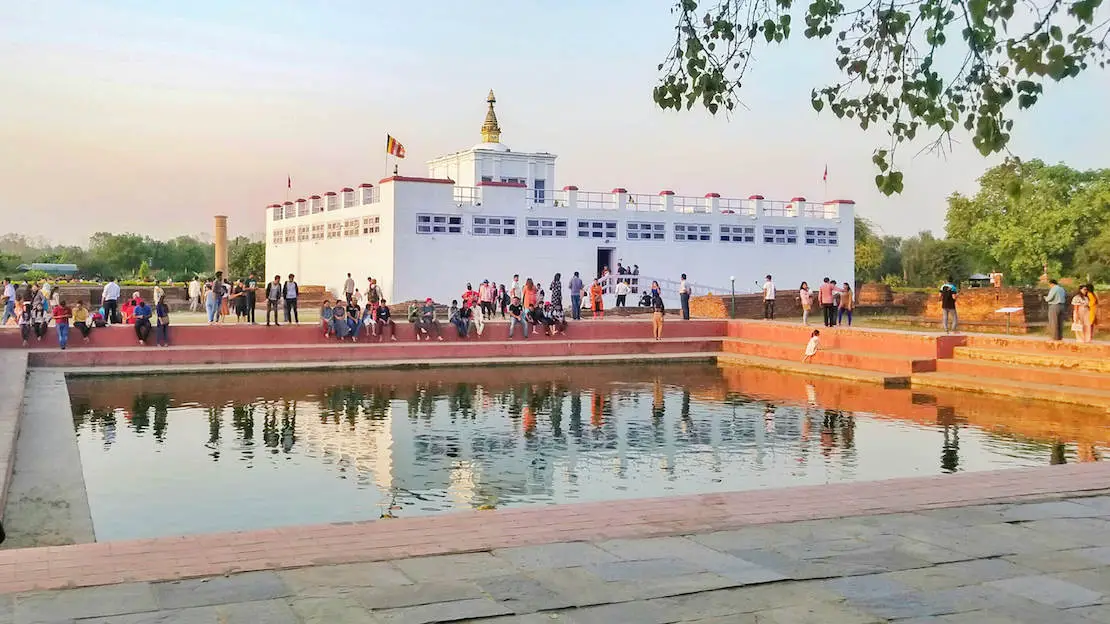
Maya Devi temple.
Bandipur
Bandipur is a still little-known destination. It is a small village in the hills of Nepal that offers a quiet place ideal for those who want to spend a few days relaxing or taking short walks.
The main attraction is probably the Tundikhel, a vantage point that on a clear day allows you to see snow-capped peaks in the distance. There are, however, other short hikes such as the one leading to the summit of Gurunche Dada (Google Maps).
Where to sleep in Bandipur?
Samira Homestay and Kayastha Lodge are both really good and cheap options. If you are looking for something more luxurious take a look at Bandipur Kaushi and Bandipur Chhen, both look great.
How to reach Bandipur?
From Pokhara or Kathmandu take any bus to Dumbre Bazaar or in most cases a bus that goes through Dumbre Bazaar, from here there are shared jeeps that leave relatively frequently to Bandipur.
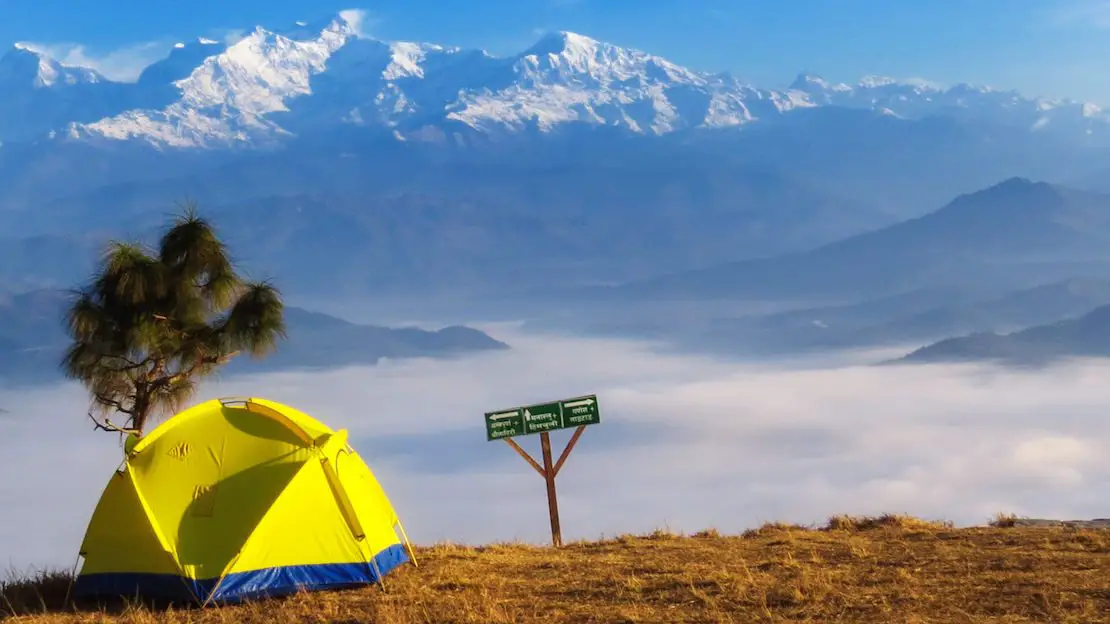
Tundikhel.
Chitwan National Park
Chitwan National Park is home to numerous animals, including rhinos, elephants, tigers, crocodiles, and various bird species. The park covers a flat, wet, and lush area, especially during the monsoon season.
The two towns that serve as the gateways and bases for exploring the park are Sauraha and Meghauli. From these towns, you can easily arrange tours and safaris to suit all tastes and budgets. While you can arrange tours from Kathmandu or Pokhara, or even online, you will definitely get the best prices locally.
For any activity inside the park, you need to pay an entrance fee of 1,700 NPR. You cannot enter the park without an organized guide or tour.
I have not personally visited the park so I invite you to read this guide.
How to reach Chitwan national park?
Whether you decide to visit the park from Sauraha or Meghauli, you must pass through the town of Narayangarh, which has frequent buses to both destinations. Narayangarh also has an airport with flights to and from Pokhara and Kathmandu.
There are direct buses from Kathmandu to Meghauli that depart every morning from Kalanki Bus Park. Generally, tour buses departing from Kathmandu and Pokhara with the destination “Chitwan National Park” go to Sauraha. However, they typically stop at a station about 7 km from the city, requiring a cab ride from there.
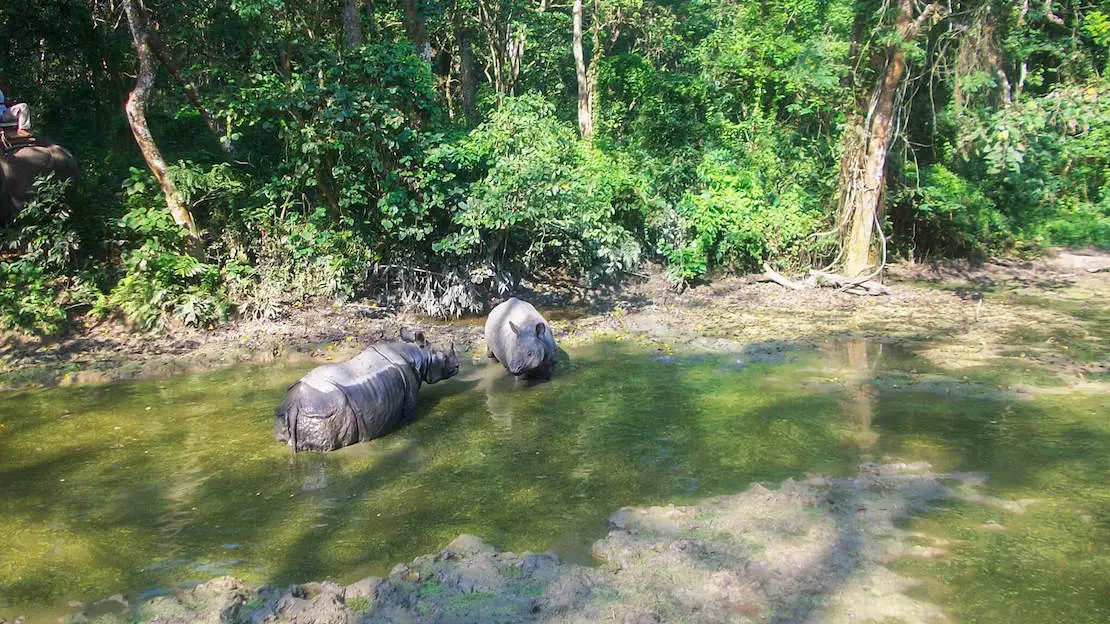
Chitwan National Park.
Trekking in Nepal
For many, a trip to Nepal is synonymous with trekking. During my two-month stay in the country, trekking occupied much of my time. By far the two most popular and easily accessible regions for completing multi-day treks are undoubtedly the Annapurna region and the Khumbu region, where Everest is located.
I have written two detailed guides for both regions.
Trekking in the Annapurna Region: on this page you will find detailed descriptions of the Annapurna Circuit, Poon Hill trek, and Annapurna Base Camp trek.
Trekking in the Khumbu (Everest) region: on this page you will find detailed descriptions of the classic route to Everest Base Camp, possible variants, and finally the Three Passes Trek.
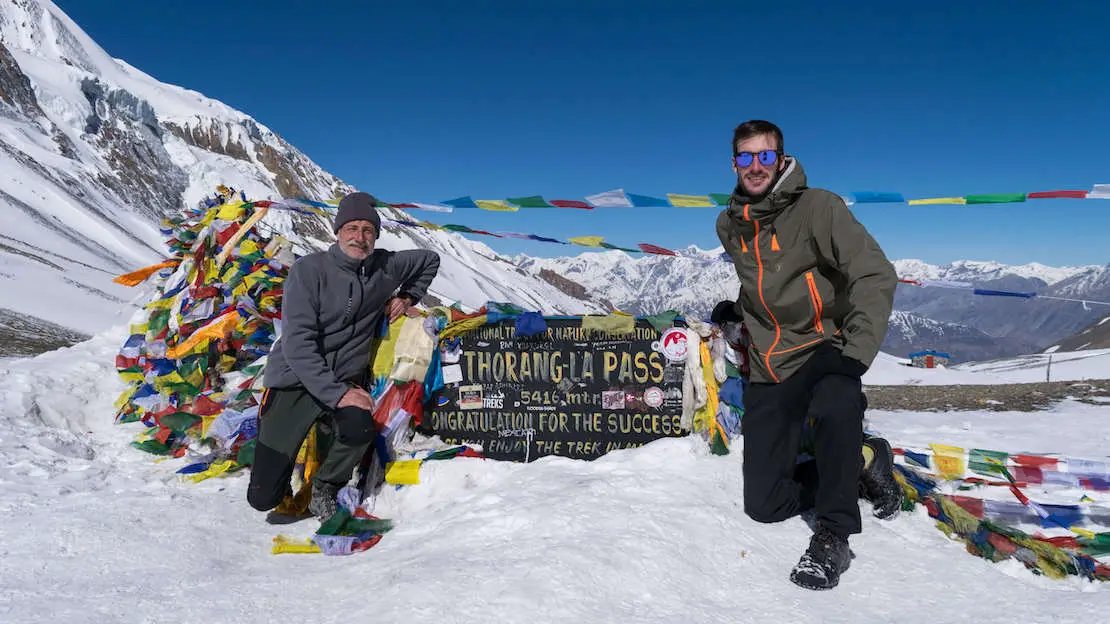
Dad and I at Thorong Pass, Annapurna circuit.
Other treks to more remote regions that are likely to require the support of local guides/agencies and in some cases having to camp a few nights are:
Manaslu: This approximately 14-day trek circumnavigates the eighth highest peak in the world (8156 m). In terms of difficulty, it is comparable to the Annapurna Circuit and Everest Base Camp treks, but it is only completed by about 2,000 people each year for two main reasons:
Firstly, before 2010, it was necessary to camp for at least one night, and even now, the lodges are very basic compared to those on other routes. Secondly, the region still requires a special permit that essentially necessitates the presence of two or more guides. This increases the costs for those seeking a do-it-yourself experience. On the other hand, the route is significantly less crowded and more authentic than the Annapurna and Everest treks. You can find a guide here.
Kanchenjunga: The trek to Kanchenjunga Base Camp (third highest mountain in the world) takes about ten days and is located in a remote area in eastern Nepal accessible by plane from Kathmandu in about 40 minutes or at the end of a 40-hour bus ride. Again, this is a protected area accessible only with the help of an organized guide/tour. You can find a guide here.
Upper Mustang: The region was officially opened to foreign trekkers only about 15 years ago, and its access is still highly restricted and one must be accompanied by a guide. Until 1950 the region was even independent from the rest of Nepal. Being in the so-called “rain shadow,” the area is suitable for trekking even during the monsoon period.
Other areas with limited access are Dolpo, Magu and Jumla. Of course there are dozens of other more or less long and popular treks but these just mentioned are in principle the main ones.
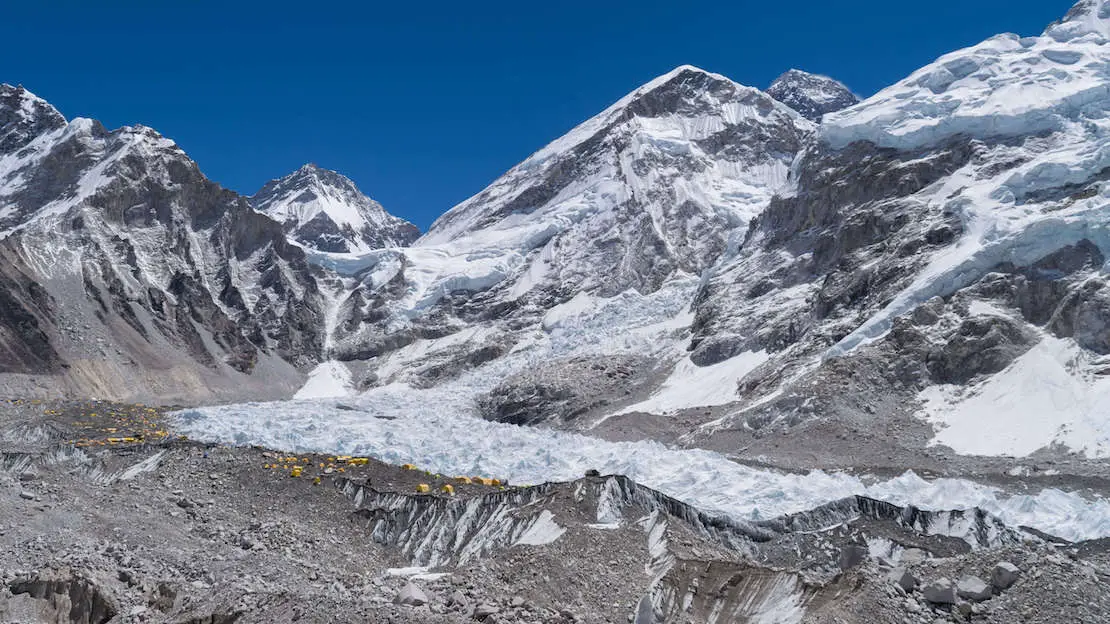
Everest base camp.
If you found this article helpful, please consider purchasing your travel insurance through one of the links on this site, doing so supports my work at no additional cost to you. For EU & UK Residents, i recommend True Traveller. For everyone else i recommend HeyMondo (5% discount). Thanks!
Suggested itineraries in Nepal
Recommending an itinerary for Nepal is really difficult as many people visit the country exclusively for trekking without devoting time to other destinations so I just recommend a short itinerary in case you are not interested in any trekking and then make some considerations in case you have more time and are interested in one of the more popular treks.
Nepal 10-day itinerary
Ten days may not seem like much time, but it’s definitely possible to explore Kathmandu and its surroundings thoroughly, along with a few additional destinations. Depending on your interests, you could even include a shorter trek like Ghorepani – Poon Hill or Annapurna Base Camp.
If you opt for multi-day treks, especially with limited time, I recommend starting early in your trip to mitigate any potential mishaps. However, if trekking isn’t on your agenda at all, here’s a suggested way to divide your days:
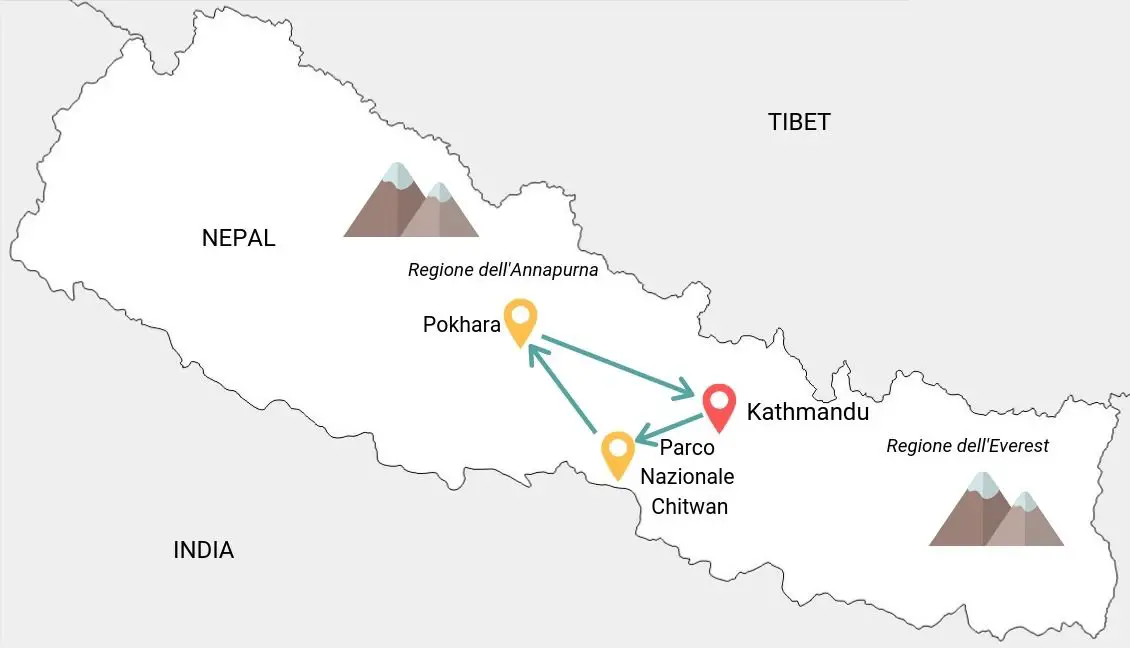
Kathmandu (3 nights)
Day 1:
Recovering from jet lag, briefly explore Thamel.
Day 2:
In the morning visit Pashupatinath Temple and the nearby Boudhanath Stupa. In the afternoon go up to the Swayambhunath Stupa (Monkey Temple). Finally head to Kathmandu Durbar Square for sunset when the square gets crowded with people.
Day 3:
I recommend spending the day between Patan and Bhaktapur.
Chitwan (2 nights)
Day 4:
Kathmandu – Chitwan bus in the morning. Arrange activities for the next day or even the same day.
Day 5:
Chitwan Park.
Pokhara (3 nights)
Day 6:
Chitwan – Pokhara bus.
Day 7 – 8:
Explore Pokhara and its surroundings.
Kathmandu (2 nights)
Day 9:
Pokhara – Kathmandu bus.
Day 10:
Return home.
Nepal 15-day itinerary
With two weeks available, longer treks like the Annapurna Circuit and Everest Base Camp are feasible, but time constraints necessitate careful choices. For Everest Base Camp, the flight to Lukla is essential, leaving little room for flexibility. Similarly, for the Annapurna Circuit, starting from Jagat and ending at Muktinath is recommended.
In my opinion, better options within this timeframe are shorter treks such as Ghorepani – Poon Hill or Annapurna Base Camp. This allows you to dedicate the remaining days to other destinations.
Nepal 3-week itinerary
With three weeks available, you have enough time to consider longer treks such as the Annapurna Circuit (approximately 10 to 20 days depending on the itinerary) or Everest Base Camp (approximately 12 to 20 days depending on the route). This time frame allows for a few extra days in case of unexpected events or to explore other destinations within the country.
My advice is to prioritize trekking, as weather conditions or unforeseen events may extend your trek by a few days. After completing the trek, you can then use the remaining days to explore additional destinations.
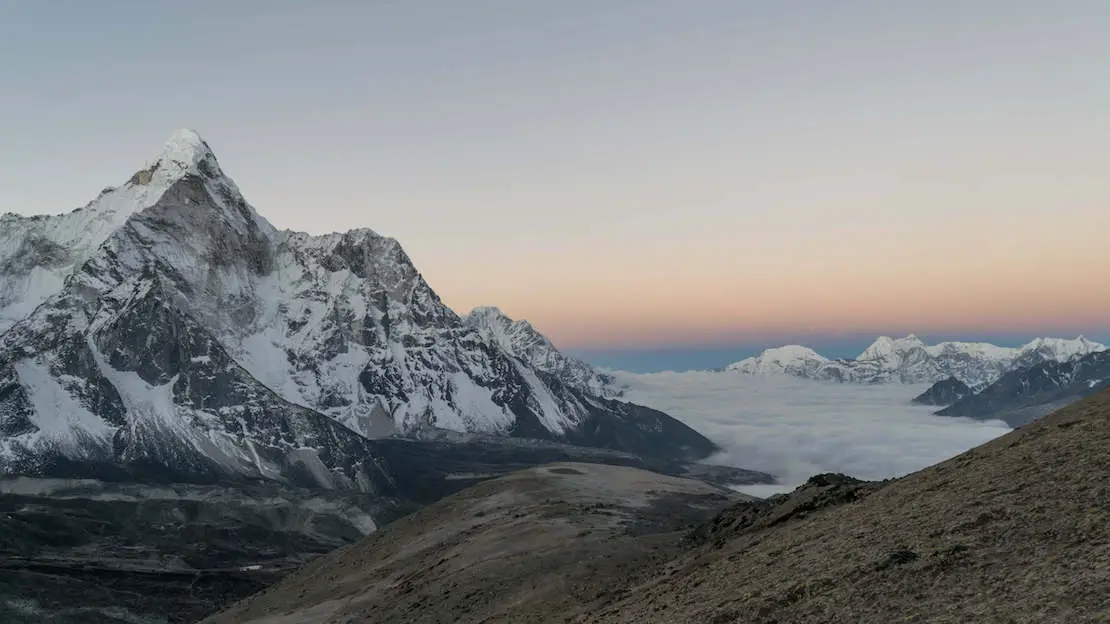
Chukhung Ri.
How to get around Nepal
Despite its small size, traveling overland in Nepal often takes longer than expected, so don’t be deceived by the distance in kilometers. For example, the road from Kathmandu to Pokhara, the country’s two main cities, spans only 200 km. However, due to frequent stops, traffic, and challenging terrain unsuitable for fast ground transportation, it typically takes no less than 6 to 7 hours by bus to cover this route.
Buses in Nepal
Buses in Nepal can be divided into three categories:
Microbuses: particularly popular especially for urban routes, they are basically minivans with 10-12 seats but can easily carry up to 20 people if needed. They are a quick and efficient way to get around but especially during rush hours they can be really full and not exactly comfortable.
Local Buses: the system is not exactly well organized and it is often difficult to figure out where they leave from but with a little research they are a really cheap way to get around but slower than Microbus and Tourist Buses. In fact, local buses stop literally everywhere to let people on and off which wastes a lot of time. It is also common practice to fill the bus to the brim, including the aisle.
Tourist Buses: as the word says, these are the buses dedicated to tourists or more generally to those who can afford to spend a little extra. Don’t expect anything luxurious but at least the seat is assigned, there are no people standing around, and except for a few predetermined stops to eat or go to the bathroom the trip usually runs fairly smoothly. However, this type of bus basically serves four destinations: Kathmndu, Chitwan, Lumbini, and Pokhara.
Jeeps: for many destinations there are jeeps that act as buses. Often they connect remote destinations where road conditions are poor, but in some cases they run along the same routes covered by buses, offering faster though not exactly more comfortable service. It is indeed standard practice to put one person next to the driver and then two rows of 4 people instead of 3 (there is a row of seats instead of a trunk) which can be really uncomfortable for long routes.
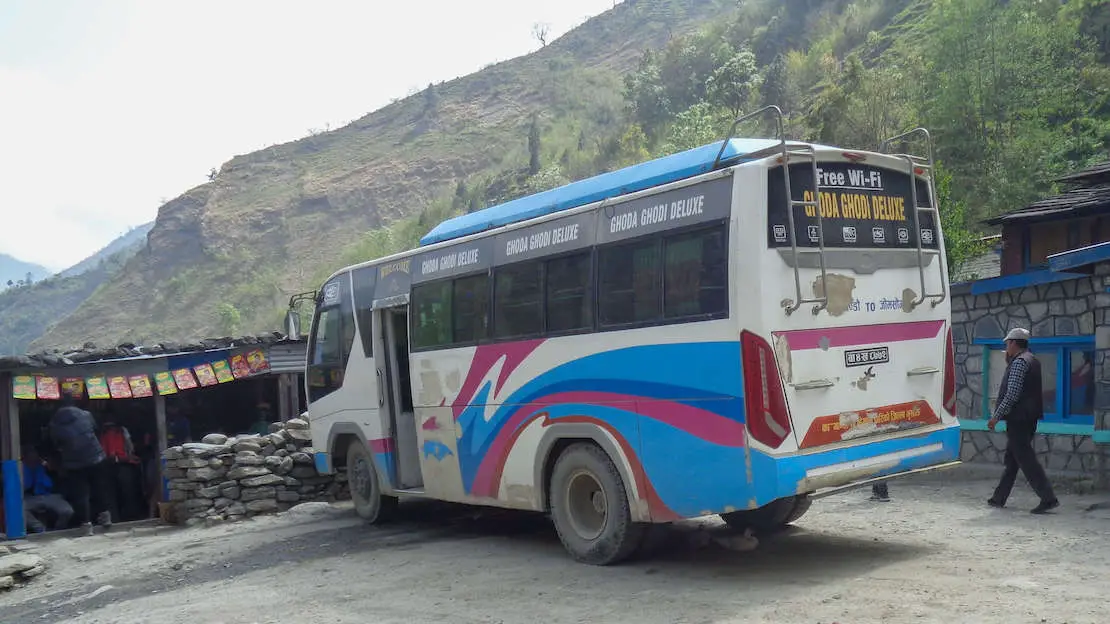
Our bus to Pokhara.
Taxis in Nepal
Taxis are really cheap by European standards and generally a great way to get around over short and medium distances for those on a budget that is not exactly tight and looking for a few extra comforts. Remember to establish the price before boarding; haggling is definitely advisable.
A taxi from the international airport to downtown Thamel officially costs 700 NPR but by bargaining you can get it down to 500/600 NPR. It is about 8 km and depending on the time of day 20/30 minutes.
Domestic flights in Nepal
There are a couple of companies that offer domestic flights between the country’s major cities but also to remote destinations. These are often small twin-engine planes in less than excellent condition, and the prices are not exactly low cost. In many cases, however, they save literally dozens of hours over road transportation, so if your budget allows they can be a good option.
It should also be kept in mind that many flights are often canceled due to weather conditions especially to high mountain destinations where the weather can be unstable even during the warm season so always leave yourself a few days of leeway.
Major airlines are: Yeti Air and Buddha Air.
Backpacking Nepal: costs
How much does a Trip to Nepal cost? Very little, for backpacking trips of 2-3 weeks, it is likely that the cost of the flight and travel insurance will exceed that of the costs incurred once you arrive at your destination. Here is an overview of costs.
N.b. If you are going to trek, keep in mind that the higher you go with altitude the higher the prices go, in some cases up to 7 or 8 times the price you would pay at the bottom of the valley.
Cost of Food in Nepal
The food is very affordable, the national dish called ‘Dal Bhat’ typically featuring rice, boiled vegetables, and lentil soup. Sometimes it includes more elaborate additions like meat, yogurt, and roti (bread). In local restaurants, this dish can cost as little as 100 NPR and often comes with additional servings. Even in moderately priced restaurants or tourist areas, it’s rare to spend more than 500 NPR on a single meal.
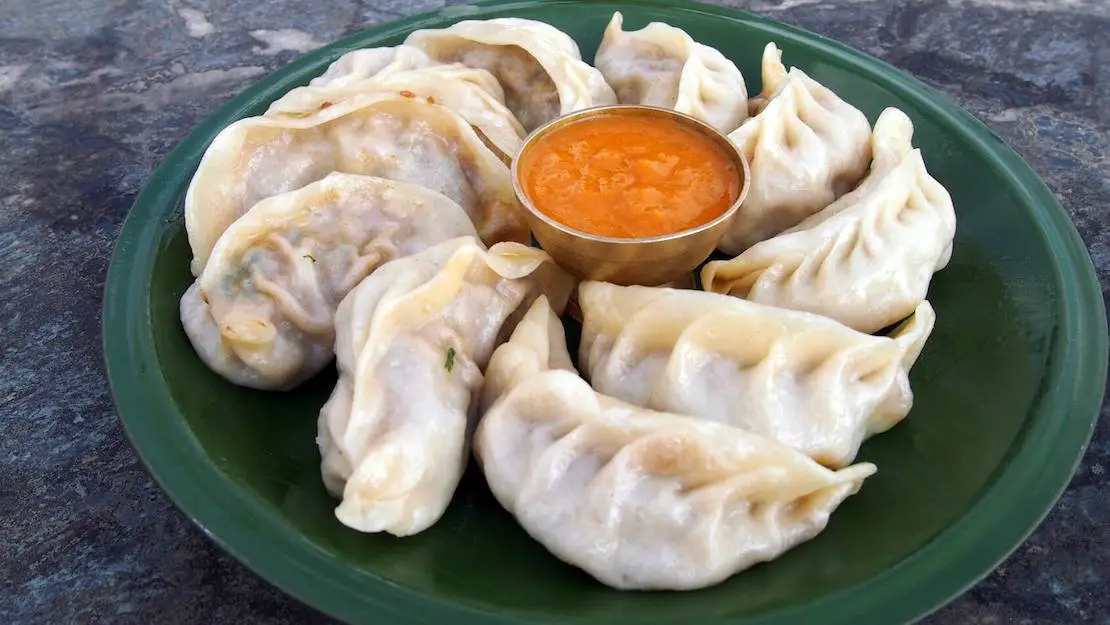
Momos.
Cost of accommodation in Nepal
A dormitory place in a good hostel ranges from 400 to 600 NPR.
A private room in a guest house or hostel from 800 to 1000 NPR.
A good hotel room from 1000 to 2000 NPR.
Lodges/tea houses along the treks often provide the room free of charge as long as meals are consumed, otherwise the cost of the room usually ranges from 100 to 500 NPR depending on the altitude.
Cost of transportation in Nepal
Getting around by local buses in the city hardly costs more than 15-25 rupees. Taxis cost approximately 50-100 rupees per kilometer but for long routes the price drops considerably. A tourist bus from Kathmandu to Pokhara or Chitwan costs about 700 to 2000 NPR depending on the service chosen. Domestic flights are quite expensive, flights of 30/40 minutes cost about $100.
In conclusion, a daily budget of 15-20€ per day in Nepal should be more than enough for most people. If you want some tips on how to save money while traveling take a look at this article.
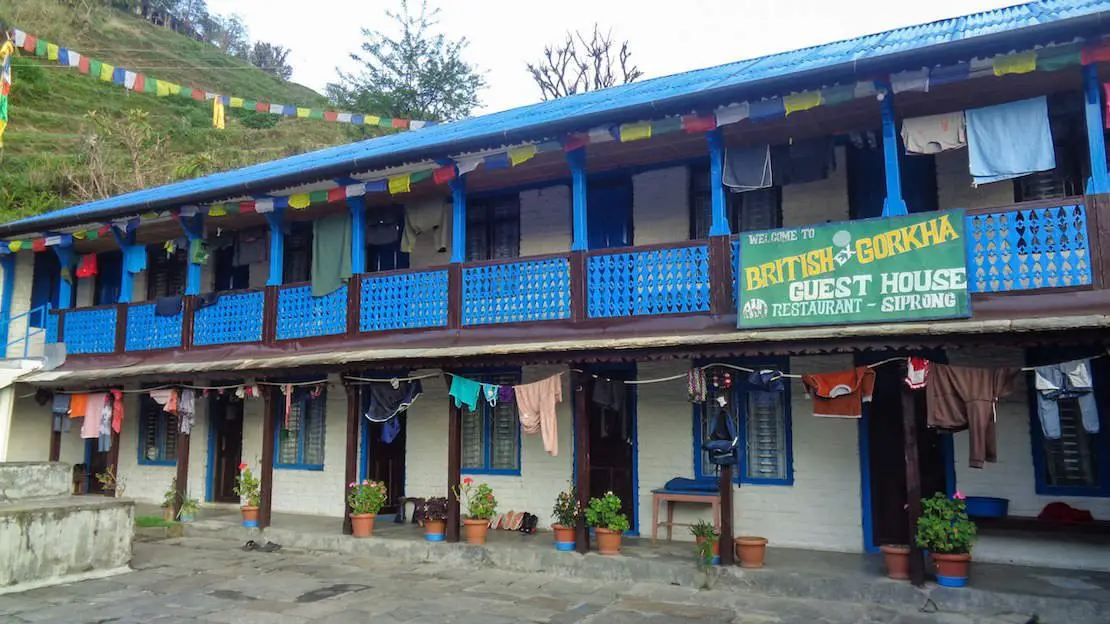
Typical mountain lodge.
Backpacking Nepal: safety
Nepal is generally a very safe country, even for solo travelers. The main precautions are necessary in the mountains, especially at high altitudes, where altitude sickness can have serious consequences.
Here are four useful tips:
- 1. The most important rule of all is to avoid overdoing it. Climb at a steady pace. Ideally, climb slower than you feel you could sustain.
- 2. Don’t underestimate the symptoms. If you experience a slight headache before bedtime and feel fine the next day, there is no problem. But if the symptoms persist, avoid gaining altitude again. Often, a day of acclimatization/rest is more than enough to continue. In some cases, it is advisable to descend a few hundred meters and, once you feel better, resume the ascent. Basically, never continue climbing if you feel sick.
- 3. After reaching 3000 meters, it is recommended to never sleep more than 500 meters above the previous night’s altitude. To be honest, we often exceeded this recommendation without any problems. In any case, I would limit myself to 700/800 meters at most.
- 4. Drink lots of water. Staying hydrated is essential.
There are also some medications, such as Diamox, that help prevent altitude sickness. However, I have no experience with them. In my opinion, it is better to listen to your body instead of relying on medications.
That said, with a bit of common sense, you shouldn’t encounter any trouble. However, Kathmandu, in particular, is known for certain scams. Be wary of “gurus” who offer blessings and then demand payment, or individuals who initially claim not to want money for their items, only to quickly ask for cash. In general, be cautious of anyone in the capital who approaches you with suspicious offers or requests.
In any case, I recommend reviewing my tips for safe travel, which apply to any destination worldwide.
Are you planning a trip to Nepal? Check out these posts:
Do you have any questions? Updated information? Feel free to leave a comment or message me on Instagram!
If you found this article helpful, please consider purchasing your travel insurance through one of the links on this site, doing so supports my work at no additional cost to you. For EU & UK Residents, i recommend True Traveller. For everyone else i recommend HeyMondo (5% discount). Thanks!
For donations/pizzas and virtual beers 🙂
Did you like the post? Pin it!
